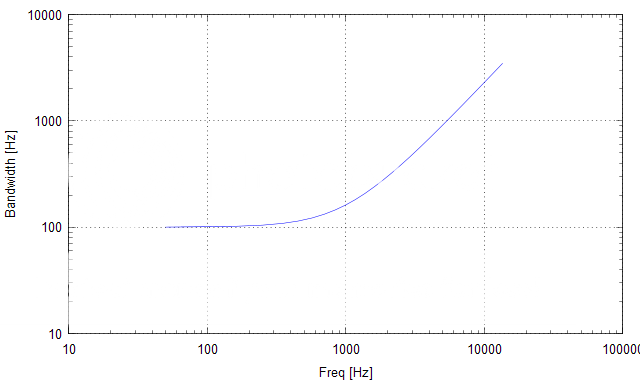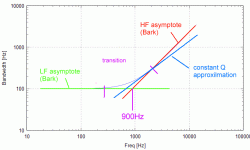Hello Soongsc,
IMHO the ideal pulse shows perfectly on the 2 graphs how the Q of the wavelets pulse evolve with frequency.
If you brose through the discussions on wavelets you may nevertheless find few examples of the same Impulse Response having been analyzed with a "continuous wavelets method" or with a "Bark wavelets method".
From memory you can see "Bark wavelets graph" ; "continuous wavelets graph" and even "multiresolution wavelets" graph for the "Ideal Reflections" test pulse
Best regards rfom Paris, France
Jean-Michel Le Cléac'h
IMHO the ideal pulse shows perfectly on the 2 graphs how the Q of the wavelets pulse evolve with frequency.
If you brose through the discussions on wavelets you may nevertheless find few examples of the same Impulse Response having been analyzed with a "continuous wavelets method" or with a "Bark wavelets method".
From memory you can see "Bark wavelets graph" ; "continuous wavelets graph" and even "multiresolution wavelets" graph for the "Ideal Reflections" test pulse
Best regards rfom Paris, France
Jean-Michel Le Cléac'h
Wouldn't it be better to compare non ideal data?
Hi,
The Bark critical bandwidth matches constant Q log-log linear bandwidth only around 2kHz. Below and above 2kHz Bark has relatively wider bandwidth than constant Q.

- Elias
The Bark critical bandwidth matches constant Q log-log linear bandwidth only around 2kHz. Below and above 2kHz Bark has relatively wider bandwidth than constant Q.

- Elias
Let's consider Elias wavelets tranform graphs of an ideal pulse (Dirac):
1) based on a Bark window
http://i952.photobucket.com/albums/ae6/_E_P_/diyaudio/Ideal_impulse_50-20kHz_Barkwavelet.png
2) based on a constant Q window
http://i952.photobucket.com/albums/ae6/_E_P_/diyaudio/Ideal_impulse_50-20kHz_constantQwavelet3.png
Despite the different horizontal scales, we can see that there is nearly no difference of shape ( between the 2 graphs above 900Hz. (which is the range of frequency that interest us when we use compression drivers and horns (most of...).
For a fractional bandwith around .7 there will be no difference at all.
Best regards from Paris, France,
Jean-Michel Le Cléac'h
Ideal conditions are too simple to see certain differences. I have seen the posts, and still think it's interesting to see these in real application.Hello Soongsc,
IMHO the ideal pulse shows perfectly on the 2 graphs how the Q of the wavelets pulse evolve with frequency.
If you brose through the discussions on wavelets you may nevertheless find few examples of the same Impulse Response having been analyzed with a "continuous wavelets method" or with a "Bark wavelets method".
From memory you can see "Bark wavelets graph" ; "continuous wavelets graph" and even "multiresolution wavelets" graph for the "Ideal Reflections" test pulse
Best regards rfom Paris, France
Jean-Michel Le Cléac'h
Hello,
An engineer will say that the constant Q approximation (blue line on the attached graph) above 900Hz of the Bark Q curve as it induces max variation of 50% or so on the Q value between 900Hz and 10000Hz is very good and sufficient for most analysis.
See attached graph.
Best regards from Paris, France
Jean-Michel Le Cléac'h
An engineer will say that the constant Q approximation (blue line on the attached graph) above 900Hz of the Bark Q curve as it induces max variation of 50% or so on the Q value between 900Hz and 10000Hz is very good and sufficient for most analysis.
See attached graph.
Best regards from Paris, France
Jean-Michel Le Cléac'h
Attachments
Hello,
Another engineer would consider what would be the benefit of constant Q over Bark, but he didn't find an answer?
- Elias
Another engineer would consider what would be the benefit of constant Q over Bark, but he didn't find an answer?
- Elias
Hello,
An engineer will say that the constant Q approximation (blue line on the attached graph) above 900Hz of the Bark Q curve as it induces max variation of 50% or so on the Q value between 900Hz and 10000Hz is very good and sufficient for most analysis.
See attached graph.
Best regards from Paris, France
Jean-Michel Le Cléac'h
Hello Elias,
Dont' think that I am opposed to the use of the Bark windowing in wavelets tranforms. It is just that I don't think they are universal and that IMHO they benefit to be used in the analysis of long duration signals as (e.g.) the response of a complete multiways system inside a listening room.
The constant Q wavelets transform operates on a fixed number of periods at every frequency and then shows the spreading of the acoustical energy in the time/frequency field with the same precision whatever is the frequency and with no modification based on psychoacoustics theories. In that sense the constant Q wavelets is a better undistorted illustration of what is the signal.
We can do a parallel with the burst decay graph (but that one has IMHO far less resolution as it distorts the time scale).
Best regards from Paris, France
Jean-Michel Le Cléac'h
Dont' think that I am opposed to the use of the Bark windowing in wavelets tranforms. It is just that I don't think they are universal and that IMHO they benefit to be used in the analysis of long duration signals as (e.g.) the response of a complete multiways system inside a listening room.
The constant Q wavelets transform operates on a fixed number of periods at every frequency and then shows the spreading of the acoustical energy in the time/frequency field with the same precision whatever is the frequency and with no modification based on psychoacoustics theories. In that sense the constant Q wavelets is a better undistorted illustration of what is the signal.
We can do a parallel with the burst decay graph (but that one has IMHO far less resolution as it distorts the time scale).
Best regards from Paris, France
Jean-Michel Le Cléac'h
Hello Jean-Michel,
I never think anything negative about you, certainly not. Constant Q is very good analysis, I'm using it since long time. But on the other hand I didn't find it ultimate for the end result, because it does not include the human perception.
I think another remarkable feature of Bark wavelet is that it is possible to present the whole audio band (50-20kHz) in a very compact form with a short time scale. Whereas for a constant Q wavelet, bass requires much longer time scales which makes it hard to observe high freq details at the same picture because of long time scale.
- Elias
I never think anything negative about you, certainly not. Constant Q is very good analysis, I'm using it since long time. But on the other hand I didn't find it ultimate for the end result, because it does not include the human perception.
I think another remarkable feature of Bark wavelet is that it is possible to present the whole audio band (50-20kHz) in a very compact form with a short time scale. Whereas for a constant Q wavelet, bass requires much longer time scales which makes it hard to observe high freq details at the same picture because of long time scale.
- Elias
Hello Elias,
Dont' think that I am opposed to the use of the Bark windowing in wavelets tranforms. It is just that I don't think they are universal and that IMHO they benefit to be used in the analysis of long duration signals as (e.g.) the response of a complete multiways system inside a listening room.
The constant Q wavelets transform operates on a fixed number of periods at every frequency and then shows the spreading of the acoustical energy in the time/frequency field with the same precision whatever is the frequency and with no modification based on psychoacoustics theories. In that sense the constant Q wavelets is a better undistorted illustration of what is the signal.
We can do a parallel with the burst decay graph (but that one has IMHO far less resolution as it distorts the time scale).
Best regards from Paris, France
Jean-Michel Le Cléac'h
New version of WTF-Package available
http://www.diyaudio.com/forums/soft...wavelet-analysis-available-2.html#post2492095
Have fun !
Michael
http://www.diyaudio.com/forums/soft...wavelet-analysis-available-2.html#post2492095
Have fun !
Michael
Hi all,
I've just found this thread while looking information about measuring horn reflections for another thread Measuring horn reflections back into the throat
I found Elias GNU Octave script from his homepage and tried to output some measurements with it but I don't know if the measurement technique could work or not ( see post #28) to identify some reflections back to the driver that could possibly be counteracted with a preconditioning filter. If it works, I don't know how to analyze the data or how to develop a preconditioning filter. Since there hasn't been much participants in the other thread maybe some of you could comment? Thanks!
I've just found this thread while looking information about measuring horn reflections for another thread Measuring horn reflections back into the throat
I found Elias GNU Octave script from his homepage and tried to output some measurements with it but I don't know if the measurement technique could work or not ( see post #28) to identify some reflections back to the driver that could possibly be counteracted with a preconditioning filter. If it works, I don't know how to analyze the data or how to develop a preconditioning filter. Since there hasn't been much participants in the other thread maybe some of you could comment? Thanks!
- Status
- This old topic is closed. If you want to reopen this topic, contact a moderator using the "Report Post" button.
- Home
- Loudspeakers
- Multi-Way
- Horn Honk $$ WANTED $$
